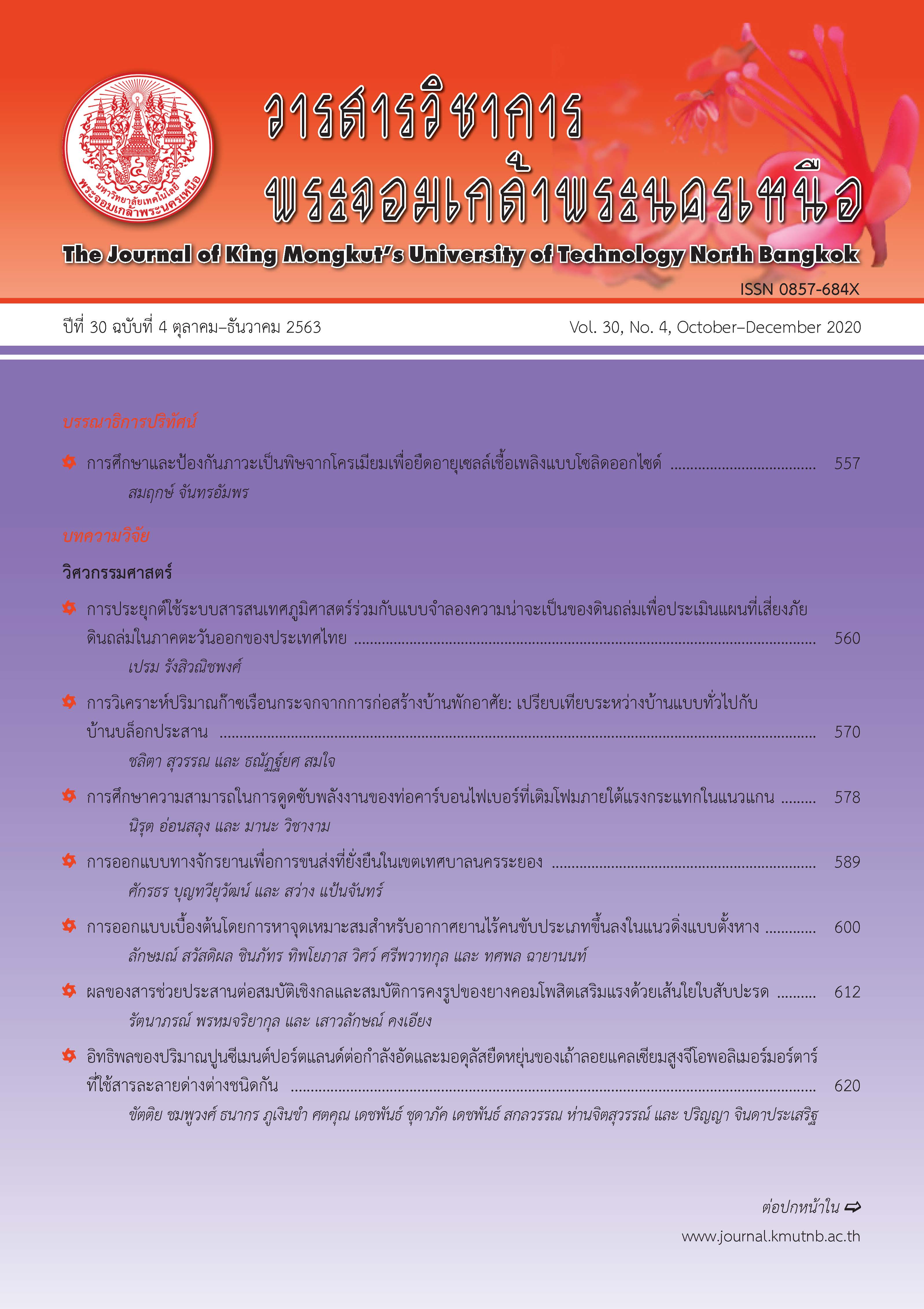การพัฒนาตัวแบบผสมเพื่อพยากรณ์ข้อมูลอนุกรมเวลาปริมาณหน่วยจำหน่ายไฟฟ้าบ้านอยู่อาศัยรายเดือนของประชาชนในเขตภาคตะวันออกเฉียงเหนือของประเทศไทย
Main Article Content
บทคัดย่อ
การวิจัยครั้งนี้มีวัตถุประสงค์เพื่อพัฒนาตัวแบบที่เหมาะสมในการพยากรณ์ข้อมูลอนุกรมเวลาปริมาณหน่วยจำหน่ายไฟฟ้าบ้านอยู่อาศัยรายเดือนของประชาชนในเขตภาคตะวันออกเฉียงเหนือ เก็บรวบรวมข้อมูลจากการไฟฟ้าส่วนภูมิภาคตั้งแต่เดือนมกราคม 2552 ถึงเดือนพฤษภาคม 2562 จำนวน 127 ค่า จำนวน 3 ชุดข้อมูล คือ กฟฉ.1 กฟฉ.2 และ กฟฉ.3 การพัฒนาตัวแบบผู้วิจัยประยุกต์ใช้เทคนิคการวิเคราะห์ข้อมูลเชิงประจักษ์เพื่อลดสัญญาณแกว่งไว (Fast Oscillation) ของข้อมูลก่อนนำไปพยากรณ์ด้วยตัวแบบอนุกรมเวลาเชิงเดี่ยว 2 วิธี คือ วิธีปรับให้เรียบเอ็กซ์โพเนนเชียลแบบโฮลท์-วินเทอร์ (Holt –Winters Exponential Smoothing Method) และตัวแบบอารีมาแบบมีฤดูกาล (Seasonal Auto – Regressive Integrated Moving Average) จากนั้นนำมาสร้างตัวแบบผสม (Hybrid Forecasting Model) ด้วยเทคนิคการพยากรณ์ร่วมและเปรียบเทียบประสิทธิภาพการพยากรณ์ด้วยเกณฑ์การวัดประสิทธิภาพ 5 เกณฑ์ ได้แก่ 1) ความคลาดเคลื่อนสัมบูรณ์เฉลี่ย 2) รากของค่าคลาดเคลื่อนกำลังสองเฉลี่ย 3) ร้อยละของความคลาดเคลื่อนสัมบูรณ์เฉลี่ย 4) เปอร์เซ็นต์ของมัธยฐานความคลาดเคลื่อนสัมบูรณ์ และ 5) เปอร์เซ็นต์ของความคลาดเคลื่อนสัมบูรณ์เฉลี่ยแบบมาตรฐาน ผลการวิจัยบ่งชี้ว่าตัวแบบผสมที่พัฒนาขึ้น มีประสิทธิภาพการพยากรณ์ดีกว่าตัวแบบอนุกรมเวลาเชิงเดี่ยว 2 ตัวแบบ ทุกเกณฑ์การวัดประสิทธิภาพการพยากรณ์ ดังนั้น สรุปได้ว่าตัวแบบผสมเป็นตัวแบบที่เหมาะสมสำหรับการพยากรณ์ข้อมูลอนุกรมเวลาปริมาณหน่วยจำหน่ายไฟฟ้าบ้านอยู่อาศัยรายเดือนของประชาชนในเขตภาคตะวันออกเฉียงเหนือของประเทศไทย
Article Details
บทความที่ลงตีพิมพ์เป็นข้อคิดเห็นของผู้เขียนเท่านั้น
ผู้เขียนจะต้องเป็นผู้รับผิดชอบต่อผลทางกฎหมายใดๆ ที่อาจเกิดขึ้นจากบทความนั้น
เอกสารอ้างอิง
[2] J. Zhang, Y.M. Wei, D. Li, Z. Tan, and J. Zhou, “Short term electricity load forecasting using a hybrid model,” Energy, no. 158, pp. 774–781, 2018.
[3] W. Yang, J. Wang, T. Niu, and P. Du, “A hybrid forecasting system based on a dual decomposition strategy and multi-objective optimization for electricity price forecasting,” Applied Energy, vol. 235, pp. 1205–1225, 2019.
[4] H. Luo, D. Wang, C. Yue, Y. Liu, and H. Guo. “Research and application of a novel hybrid decomposition-ensemble learning paradigm with error correction for daily PM 10 forecasting,” Atmospheric Research, vol. 201, pp. 34–45, 2018.
[5] Y. Cheng, H. Zhang, Z. Liu, L. Chen, and P. Wang, “Hybrid algorithm for short-term forecasting of PM2.5 in China,” Atmospheric Environment, vol. 200, pp. 264–279, 2019.
[6] M. Manmin, Time Series and Forecasting. Bangkok : Four Printing, 2006 (in Thai).
[7] N. Papukdee, N. Senawong, and P. Busababodhin, “A comparative forecasting model of monthly rainfall in Northeast of Thailand,” The Journal of KMUTNB, vol. 29, no. 2, pp. 302–313, 2019 (in Thai).
[8] Z. Yang and J.Wang, “A hybrid forecasting approach applied in wind speed forecasting based on a data processing strategy and an optimized artificial intelligence algorithm,” Energy, vol. 160, pp. 87–100, 2018.
[9] M. Santhosh, C. Venkaiah, and D. M. Vinod Kumar, “Ensemble empirical mode decomposition based adaptive wavelet neural network method for wind speed prediction,” Energy Conversion and Management, vol. 168, pp. 482–493, 2018.
[10] Y. Yaslan and B. Bican, “Empirical mode decomposition based denoising method with support vector regression for time series prediction: A case study for electricity load forecasting,” Measurement, vol. 103, pp. 52–61, 2017.
[11] J. F. Rendon-Sanchez and L. M. de Menezes, “Structural combination of seasonal exponential smoothing forecasts applied to load forecasting,” European Journal of Operational Research, vol. 275, no. 3, pp. 916–924, 2019.
[12] Power Economics Division, “Electricity Sales Report” Provincial Electricity Authority, Bangkok, Thailand. Accessed: March, 2019. [Online]. Available: http://peaoc.pea.co.th/ped/
[13] N. Huang, Z. Shen, S. Long, M. Wu, H. Shih, Q. Zheng, N. Yen, C. Tung, and H. Liu, “The empirical mode decomposition and the Hilbert spectrum for nonlinear and non-stationary time series analysis,” in Proceedings of The Royal Society a Mathematical Physical and Engineering Sciences, 1998, no. 454, pp. 903–995, 1998.
[14] G. E. P. Box, G. M. Jenkins, G. C. Reinsel, and G. M. Ljung, Time Series Analysis: Forecasting and Control, 4th ed., New Jersey: John Wiley and Sons, Inc., 2008.
[15] R Core Team. forecast: Forecasting Functions for Time Series and Linear Models. R Foundation for Statistical Computing, Vienna, Austria. Accessed: March 2019. [Online]. Available: https://cran.rproject.org/web/packages/forecast/

